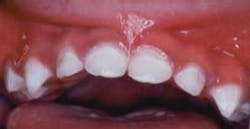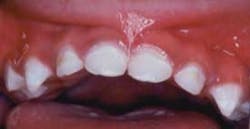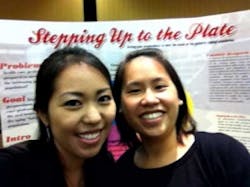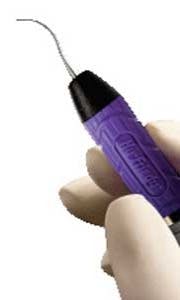Student poster sessions, table clinics from ADHA annual session featured
by Maria Perno Goldie, RDH, MS
Infant Oral Health Education in Michigan Dental Hygiene Programs
Sarah Barbuscak, Rebecca Cathey, Katherine Hanner, and Lindsey Respondek, students from the University of Detroit Mercy, School of Dentistry
Infant Oral Health Education in Michigan Dental Hygiene Programs
Sarah Barbuscak, Rebecca Cathey, Katherine Hanner, and Lindsey Respondek, students from the University of Detroit Mercy, School of Dentistry
As part of the dental team, hygienists have a significant role in promoting oral health in the prevention of oral diseases in infants and children. The purpose of this study was to evaluate didactic and clinical curricula of dental hygiene programs in Michigan regarding infant oral health (IOH). A questionnaire was sent to all dental hygiene program directors in Michigan. Questions were related to inclusion of IOH in the curriculum, methods and materials used for teaching, IOH topics being taught, clinical experiences, didactic hours, and obstacles that each program may experience with teaching IOH. Findings showed that all programs teach IOH; 100% of the programs utilized lectures, 70% used videos, online presentations, community rotation and handouts. An average of four didactic hours was devoted to IOH. Only 30% of the directors reported that their hygiene students have experience in clinic patient care. In addition, 44% of the directors considered their students competent upon graduation in providing infant oral health education. Editorial note - For further reading, visit the American Academy of Pediatric Dentistry (AAPD) “Guidelines on Infant Oral Health Care” at www.aapd.org/media/policies_guidelines/g_infantoralhealthcare.pdf. Improving Perinatal and Infant Oral Health (AAPD) at www.cdhp.org/programs/improving_perinatal_and_infant_oral_health_aapd/improving_perinatal_and_infant_oral_health_. First 5 California at www.first5california.com/. Bright Futures Toolbox: Health Professionals and Human Services Providers at www.mchoralhealth.org/Toolbox/professionals.html. Stepping Up to the Plate
Jennifer Takata and Melinda Lau, students from the University of Hawaii at Manoa
Jennifer Takata and Melinda Lau, students from the University of Hawaii at Manoa
The question posed by these students was: “Are dental health care professionals prepared to meet the needs of the increasing geriatric (aging) population?” Their goal is to improve the preparedness of dental health care professionals to meet the oral health needs of the aging “baby boomer” population. They mentioned that baby boomers were born between 1946 and 1964, and by 2030, twenty percent of the U.S. population will represent 65 years of age or older. (Baby Boom Population. U.S. Census Bureau. USA and by State www.boomerslife.org/baby_boom_population_us_census_bureau_by_state.htm). Stepping Up to the Plate is a module designed to improve the preparedness of dental health care professionals to meet the oral health needs of the aging “baby boomer” population in three skill areas: cognitive, psychomotor, and attitudinal, and in understanding the role of finances in access to care. The module includes common medical conditions, related oral health needs, common drugs, oral hygiene aids, safe wheelchair transfer, and financial impact. The module enables the oral health professional to utilize a self-paced independent-learning modality. An interactive baseball-themed game, Stepping Up to the Plate, serves as a post-test following completion of the module.Alternative Smoking Using a Hookah or Bidi Cigarette: Implications on Oral Health
Toni-Ann Restivo, AS, BS, student at New York City College of Technology’s (City Tech).This poster and brochure highlighted the growing fad of smoking tobacco through a hookah, or water pipe. It has become a very popular social activity for young Americans, including college students. Hookah cafés and bars have proliferated in the past decade in the USA, and have always been popular in other parts of the world. “Hookah smoking originated in India roughly 400 years ago, as did the smoking of “bidi” cigarettes, made by rolling tobacco in the leaves of the tendu tree and sometimes flavoring them for sweetness. As anti-smoking legislation continues to build, bidi cigarettes have become scarce in the New York metropolitan area, while hookah smoking opportunities, even for those of high school age, have become easier to find at lounges, bars, or restaurants offering DJs, dancing, table service, and occasionally an outdoor patio. In 2003, New York Magazine even named the top five hookah bars.” (Brooklyn, N.Y. -- July 6, 2011 -- New York City College of Technology Press Release).
Toni-Ann Restivo, AS, BS, student at New York City College of Technology’s (City Tech).This poster and brochure highlighted the growing fad of smoking tobacco through a hookah, or water pipe. It has become a very popular social activity for young Americans, including college students. Hookah cafés and bars have proliferated in the past decade in the USA, and have always been popular in other parts of the world. “Hookah smoking originated in India roughly 400 years ago, as did the smoking of “bidi” cigarettes, made by rolling tobacco in the leaves of the tendu tree and sometimes flavoring them for sweetness. As anti-smoking legislation continues to build, bidi cigarettes have become scarce in the New York metropolitan area, while hookah smoking opportunities, even for those of high school age, have become easier to find at lounges, bars, or restaurants offering DJs, dancing, table service, and occasionally an outdoor patio. In 2003, New York Magazine even named the top five hookah bars.” (Brooklyn, N.Y. -- July 6, 2011 -- New York City College of Technology Press Release).
It was discussed that many mistakenly assume that smoking tobacco through a hookah filters out harmful ingredients, and is less harmful than cigarette or cigar smoking. Since the tobacco is often fruit-flavored, it entices smokers, and they do not associate it with a cancer-causing substance. Components of a hookah, the tobacco content, carcinogens, and health implications were all discussed.Bidis were also a topic of the presentation. It was pointed out that smokers perceive bidis as being more “natural” than tobacco cigarettes; however, they contain natural carcinogens. Bidis do not stay lit consistently, so smokers draw deeply on the cigarettes to keep them burning. Both hookah and bidi smoking also generate second hand smoke, which affects non-smokers in the vicinity. ADHA Undergraduate Table Clinics at the 2011 CLL at Annual Session in Nashville, Tenn. The winners for the table clinics are below. Congratulations to all!
Table Clinic 1st Place
Dental Stem Cells: You Can Bank on Them, Harrisburg Area Community College, Rebecca Boyles and Maureen Trnka Table Clinic 2nd Place
Xylitol Syrup Never Tasted So Sweet, University of Southern California, Robin Nanda, David Tran, and Cristy Bentley Table Clinic 3rd Place
Alternative Smoking Using Hookah or Bidi Cigarettes: Implications on Oral Health, New York City College of Technology, Toni-Ann Restivo Table Clinic Honorable Mention
Connecting the Dots: TMD & Body Posture, Cerritos College, Katherine Carter and Jennifer Edington
Dental Stem Cells: You Can Bank on Them, Harrisburg Area Community College, Rebecca Boyles and Maureen Trnka Table Clinic 2nd Place
Xylitol Syrup Never Tasted So Sweet, University of Southern California, Robin Nanda, David Tran, and Cristy Bentley Table Clinic 3rd Place
Alternative Smoking Using Hookah or Bidi Cigarettes: Implications on Oral Health, New York City College of Technology, Toni-Ann Restivo Table Clinic Honorable Mention
Connecting the Dots: TMD & Body Posture, Cerritos College, Katherine Carter and Jennifer Edington
Maria Perno Goldie, RDH, MS
To read previous articles in RDH eVillage FOCUS from 2011 written by Maria Perno Goldie, go to articles.





